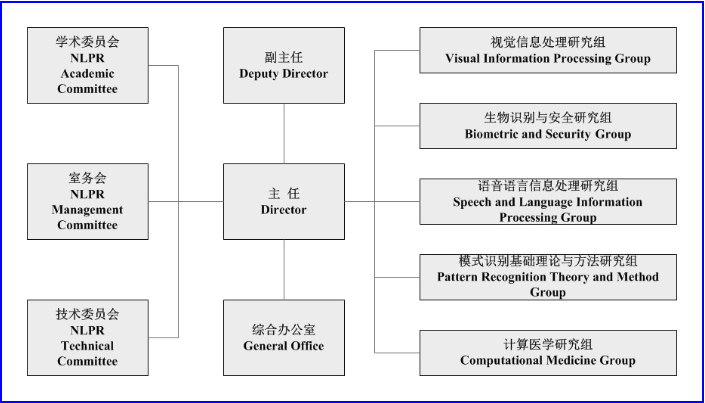National Laboratory of Pattern Recognition (NLPR) approved by State Development Planning Commission was built in 1984. In 1987 it passed state examination and was formally open to the outside, relied on Institute of Automation, Chinese Academy of Sciences (CASIA), as one of the first state key laboratories in China. The first director of NLPR is Prof. MA Songde, who is the incumbent vice minister of Ministry of Science and Technology (MOST). The incumbent director of NLPR is Prof. LIU Chenglin. Prof. TAN Tieniu, CAS Member, is the director of academic committee.
Currently, the faculty consists of 104 staff researchers supported by a team of young talents with 80% of researchers younger than 45. 6 researchers are winners of National Natural Science Fund for Distinguished Young Scholars and 2 staffs are foreign researchers. Additionally, NLPR has 384 floating population, including 11 postdoctoral fellows, 176 PhD students, 86 MSc and 176 PhD students, as well as hired staff, senior visiting researchers from China and overseas. Admittedly, NLPR has formed an energetic team of young talented researchers active in cutting-edge research in the broad field of Pattern Recognition, with specific interests in pattern recognition, computer vision, image processing and graphics, speech and language processing, natural language processing (NLP) and application and system of pattern recognition etc.

At present, NLPR has born hundreds of scientific research projects, including National Basic Research Program of China (973 Program), NSFC General Program (Key Program, Major Research Plan), National Science Fund for Distinguished Young Scholars, National Science Fund for Creative Research Groups, National High-tech R&D Program of China (863 Program), National Key Technologies R&D Program of China and International Cooperation Project etc.
NLPR members have widely published hundreds of papers in leading national and international journals and conferences each year, such as IEEE Transactions on PAMI, IEEE Transactions on Medical Imaging, NeuroImage, Human Brain Mapping, Automatica, EuroSpeech, Pattern Recognition, Pattern Recognition Letters, Eurospeech, IJCV, ICASSP, ICSLP, ICCV, ICPR, CVPR,MICCAI, ACCV, etc. In addition, NLPR members are also active in program committees and editorial boards of these journals and conferences. NLPR have also organized and hosted national and international conferences or workshops in its fields.
In recent years, NLPR has been granted and applied for 26 patents for invention, 1 second price of National Scientific and Technological Progress Award, 2 second prizes of CAS National Science, 3 third prizes of other ministries and commissions, 1 gold medal of International Invention Gold Award and 1 World Intellectual Property Special Award.
NLPR is also keen on establishing academic links with world leading research laboratories. Depending on various opportunities, NLPR actively organizes academic exchange. Each year excellent Chinese students studying in America, France, Germany, Japan, Britain, Singapore etc. have regularly engaged in short-time visiting research and dozens of notable scholars from Canada, America, France and Japan etc. have come to NLPR to give a speech. Via CASIA and Institut national de recherche en informatique et en automatique (INRIA), NLPR has established Sino-French Laboratory for Computer Science, Automation and Applied Mathematics (LIAMA). It has also built Joint Laboratory of Information Technology jointly funded by Hong Kong University of Science and Technology.
With rapid development of high-tech enterprises, NLPR also take an active part in exchange and cooperation with enterprises and in future it wishes to serve economic construction and social development of China through efficient combination with social resources to promote achievements transformation.

